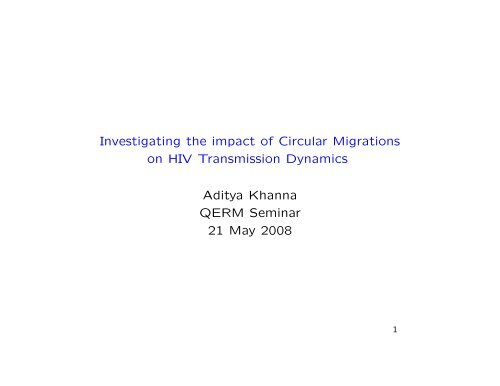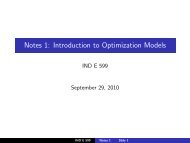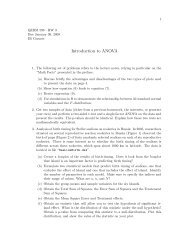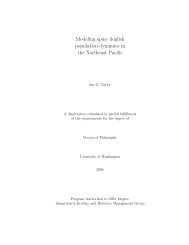Investigating the impact of Circular Migrations on HIV ... - CBR Wiki
Investigating the impact of Circular Migrations on HIV ... - CBR Wiki
Investigating the impact of Circular Migrations on HIV ... - CBR Wiki
You also want an ePaper? Increase the reach of your titles
YUMPU automatically turns print PDFs into web optimized ePapers that Google loves.
The Questi<strong>on</strong>How do circular migrati<strong>on</strong>s affect <str<strong>on</strong>g>the</str<strong>on</strong>g> dynamics<str<strong>on</strong>g>of</str<strong>on</strong>g> <strong>HIV</strong> transmissi<strong>on</strong> through a populati<strong>on</strong>?3
The Questi<strong>on</strong>How do circular migrati<strong>on</strong>s affect <str<strong>on</strong>g>the</str<strong>on</strong>g> dynamics<str<strong>on</strong>g>of</str<strong>on</strong>g> <strong>HIV</strong> transmissi<strong>on</strong> through a populati<strong>on</strong>?• Frequency <str<strong>on</strong>g>of</str<strong>on</strong>g> migrant return• Sexual behaviour <str<strong>on</strong>g>of</str<strong>on</strong>g> migrants and n<strong>on</strong>-migrants +partner(s)• Recency <str<strong>on</strong>g>of</str<strong>on</strong>g> transmissi<strong>on</strong>.• C<strong>on</strong>current partnerships4
Outline1. Motivati<strong>on</strong> - The Research Questi<strong>on</strong>2. Background3. Mechanisms4. Modeling5. Discuss!5
Lurie et. al. (2003)• 196 migrant men + 130 rural partners• 64 n<strong>on</strong> migrant men + 98 rural partners• Detailed questi<strong>on</strong>naire + Blood samples9
• 25.9% migrant men + 12.7% n<strong>on</strong> migrant men<strong>HIV</strong>+• 21% <str<strong>on</strong>g>of</str<strong>on</strong>g> partners <str<strong>on</strong>g>of</str<strong>on</strong>g> migrant men, 17% partners <str<strong>on</strong>g>of</str<strong>on</strong>g>n<strong>on</strong>migrant men.• Female partner infected in ≈ 1/3rd <str<strong>on</strong>g>of</str<strong>on</strong>g> discordantpartnerships.• Greater likelihood <str<strong>on</strong>g>of</str<strong>on</strong>g> being infected from outsideprimary relati<strong>on</strong>ship.• <str<strong>on</strong>g>Investigating</str<strong>on</strong>g> Bi-directi<strong>on</strong>ality is crucial.10
Outline1. Motivati<strong>on</strong> - The Research Questi<strong>on</strong>2. Background3. Mechanisms4. Modeling5. Discuss!11
Major Factors1. Migrants’ high risk sexual behaviour.2. Bi-directi<strong>on</strong>ality <str<strong>on</strong>g>of</str<strong>on</strong>g> disease transmissi<strong>on</strong>3. C<strong>on</strong>current Partnerships4. Recency <str<strong>on</strong>g>of</str<strong>on</strong>g> transmissi<strong>on</strong>12
C<strong>on</strong>current Partnerships: Relati<strong>on</strong>ships that overlap intime.13
Definiti<strong>on</strong> <str<strong>on</strong>g>of</str<strong>on</strong>g> C<strong>on</strong>currency(Morris, Kretzcshmar)Serial M<strong>on</strong>ogamy12345timeC<strong>on</strong>currency1234514
Populati<strong>on</strong> Level Structure(Morris and Kretzschmar)m<strong>on</strong>ogamyc<strong>on</strong>currencyVirus Perspective: Less time locked in samepartnership.15
Simulating Impact <str<strong>on</strong>g>of</str<strong>on</strong>g> C<strong>on</strong>currency(Morris and Kretzschmar, 1997)Number <str<strong>on</strong>g>of</str<strong>on</strong>g> Infected500 1000 15000.0 0.1 0.2 0.3 0.4 0.5 0.6 0.7C<strong>on</strong>currency16
Major Factors1. Migrants’ high risk sexual behaviour.2. Bi-directi<strong>on</strong>ality <str<strong>on</strong>g>of</str<strong>on</strong>g> disease transmissi<strong>on</strong>3. C<strong>on</strong>current Partnerships4. Recency <str<strong>on</strong>g>of</str<strong>on</strong>g> infecti<strong>on</strong>17
Outline1. Motivati<strong>on</strong> - The Research Questi<strong>on</strong>2. Background3. Mechanisms4. Modeling5. Discuss!18
Social Networks: Why use this paradigm?• Social Networks provide a framework to keep track<str<strong>on</strong>g>of</str<strong>on</strong>g> all nodes and <str<strong>on</strong>g>the</str<strong>on</strong>g> ties <str<strong>on</strong>g>the</str<strong>on</strong>g>y are involved in.• C<strong>on</strong>ducive to an agent-based investigati<strong>on</strong> <str<strong>on</strong>g>of</str<strong>on</strong>g> relati<strong>on</strong>altiming and c<strong>on</strong>necti<strong>on</strong> to c<strong>on</strong>currency19
A Social Network is defined as a set <str<strong>on</strong>g>of</str<strong>on</strong>g> n social actorsand a relati<strong>on</strong>ship between each pair <str<strong>on</strong>g>of</str<strong>on</strong>g> factors (Handcock,2008).Define a sociomatrix Y with 1, . . . , n actors. ThenY ij ={1 if relati<strong>on</strong>ship exists from actor i to actor j0 elseNote: The tie is <str<strong>on</strong>g>the</str<strong>on</strong>g> variable <str<strong>on</strong>g>of</str<strong>on</strong>g> interest.Fundamental Problem:P (Y = y).Specifying a distributi<strong>on</strong> for20
Exp<strong>on</strong>ential Random Graph Model:P (Y = y) = 1 κ exp {∑ A η A g A (y)}• General class <str<strong>on</strong>g>of</str<strong>on</strong>g> models.• Summati<strong>on</strong> is over all possible c<strong>on</strong>figurati<strong>on</strong>s.• η A parameter corresp<strong>on</strong>ding to c<strong>on</strong>figurati<strong>on</strong> A.• g A (y) = ∏ y ij ∈A y ij ={1 if c<strong>on</strong>figurati<strong>on</strong> exists in network0 else}• κ is normalizing quantity21
Estimati<strong>on</strong>: κ makes estimati<strong>on</strong> difficult.C<strong>on</strong>sider transformati<strong>on</strong>:log⎡⎣ P (Y ij = 1|y c ij )P (Y ij = 0|y c ij⎤⎦ =∑A(Y ij )η A d A (y)• Sum over all c<strong>on</strong>figurati<strong>on</strong>s A that c<strong>on</strong>tain Y ij• η A corresp<strong>on</strong>ds to c<strong>on</strong>figurati<strong>on</strong> A.• d A (y) = change statistic: Switch toggled from <strong>on</strong>to <str<strong>on</strong>g>of</str<strong>on</strong>g>f.22
Bernoulli Random Graph (Erdos-Renyi Model).⎛ ⎞P (Y = y) = 1 κ exp η ij y ij⎠⎝ ∑ i,j• Every possible edge Y ij is a c<strong>on</strong>figurati<strong>on</strong>• Parameter η ij is a parameter for each c<strong>on</strong>figurati<strong>on</strong>• Statistic g ij (y) = y ij indicates existence <str<strong>on</strong>g>of</str<strong>on</strong>g> c<strong>on</strong>figurati<strong>on</strong>.23
Rural Women Urban WomenMigrant Men ̌ ̌N<strong>on</strong>Migrant Men ̌ ✘24
• Village, Town, and <str<strong>on</strong>g>Migrati<strong>on</strong>s</str<strong>on</strong>g> between.• Identify Change Statisticsso part-• Populati<strong>on</strong> reaches a “stati<strong>on</strong>ary” state:nerships have formed.• Simulate transmissi<strong>on</strong> <str<strong>on</strong>g>of</str<strong>on</strong>g> <str<strong>on</strong>g>the</str<strong>on</strong>g> disease through <str<strong>on</strong>g>the</str<strong>on</strong>g>network.• About 3 m<strong>on</strong>ths later - migrants return home and anew batch <str<strong>on</strong>g>of</str<strong>on</strong>g> migrants go to mine. Process repeats.25
Take Home Messages• Not much is known about <str<strong>on</strong>g>the</str<strong>on</strong>g> <str<strong>on</strong>g>impact</str<strong>on</strong>g> <str<strong>on</strong>g>of</str<strong>on</strong>g> migrati<strong>on</strong><strong>on</strong> how STI’s travel through populati<strong>on</strong>s.• Good data <strong>on</strong> sexual behaviour is hard to find.• Process based models can help us gain insight intothis problem with <str<strong>on</strong>g>the</str<strong>on</strong>g> goal <str<strong>on</strong>g>of</str<strong>on</strong>g> effective interventi<strong>on</strong>strategies.26
Thanks:• Steven Goodreau and Susan Cassels• <str<strong>on</strong>g>the</str<strong>on</strong>g> UW NetModeling Group• QERMies• Anders<strong>on</strong> Lab27







